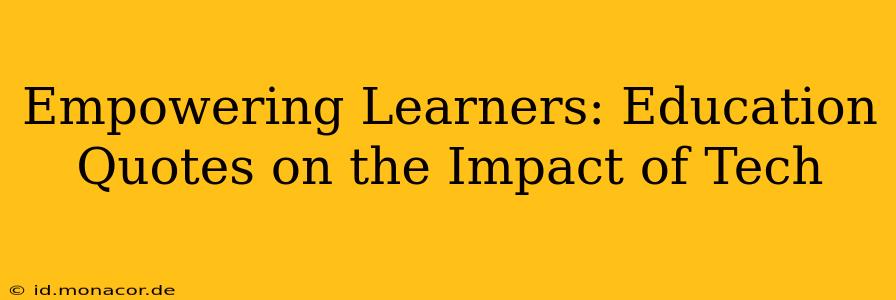Technology's integration into education is transforming how we teach and learn. From interactive whiteboards to personalized learning platforms, the digital age offers unprecedented opportunities to empower learners. This post explores the profound impact of technology in education, drawing upon insightful quotes from prominent figures and examining the key questions surrounding its effective implementation.
What are the benefits of technology in education?
Technology offers a multitude of benefits, enhancing the learning experience in numerous ways. It fosters interactive and engaging learning environments, caters to diverse learning styles, and provides personalized feedback and support. The use of technology promotes collaboration, problem-solving, and critical thinking skills, crucial for success in the 21st century. Furthermore, digital resources expand access to information and learning materials, breaking down geographical barriers and creating opportunities for lifelong learning.
How does technology enhance student engagement?
One of the most significant advantages of technology in education is its ability to boost student engagement. Interactive simulations, gamified learning platforms, and multimedia content captivate students' attention and make learning more enjoyable. Technology allows for personalized learning pathways, adapting to individual student needs and paces. This personalized approach fosters a sense of ownership and control over their learning journey, leading to increased motivation and engagement. The collaborative nature of many technological tools also encourages peer-to-peer learning and interaction, further enhancing engagement levels.
What are the challenges of integrating technology in education?
Despite the numerous benefits, integrating technology in education presents challenges. The digital divide, unequal access to technology and internet connectivity, remains a significant barrier for many students. Teacher training and professional development are crucial to ensure effective implementation and appropriate pedagogical approaches. Moreover, the cost of acquiring and maintaining technology infrastructure can be substantial, placing a burden on schools and educational institutions. Finally, the ethical considerations surrounding data privacy, cybersecurity, and responsible technology use must be carefully addressed.
How can technology be used to personalize learning?
Technology enables personalized learning by providing adaptive learning platforms that adjust to individual student needs. These platforms track student progress, identify areas where they excel or struggle, and adapt the learning path accordingly. Artificial intelligence (AI) is playing an increasingly important role in this personalization, providing customized feedback, recommending relevant resources, and offering targeted support. This tailored approach ensures that every student receives the individualized attention and support they require to achieve their full potential.
What are some examples of effective technology use in education?
Numerous examples showcase the effective use of technology in education. Interactive whiteboards create dynamic learning environments, while virtual reality (VR) and augmented reality (AR) technologies offer immersive learning experiences. Learning management systems (LMS) provide a centralized platform for course materials, assignments, and communication. Online collaboration tools facilitate teamwork and peer-to-peer learning, while educational apps and games make learning fun and engaging. The use of technology extends beyond the classroom, with online courses and blended learning models expanding access to education for a wider audience.
What are the ethical considerations of using technology in education?
Ethical considerations are paramount when integrating technology in education. Data privacy and security are crucial, ensuring that student data is protected and used responsibly. The potential for algorithmic bias in AI-powered learning platforms must be addressed to ensure equitable outcomes for all students. Digital citizenship education is vital to teach students responsible technology use, online safety, and ethical digital behavior. Finally, the balance between screen time and other learning activities must be carefully considered to promote holistic development.
Conclusion: Embracing the Future of Learning
Technology is revolutionizing education, offering powerful tools to empower learners and create more engaging and effective learning experiences. While challenges remain, the potential benefits are immense. By thoughtfully addressing the ethical considerations and ensuring equitable access, we can harness the transformative power of technology to shape a future where every student has the opportunity to thrive. The quotes from educational leaders throughout history underscore the enduring importance of access, personalized learning, and student-centric approaches—all of which technology can help facilitate and amplify.

